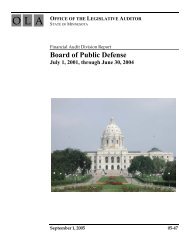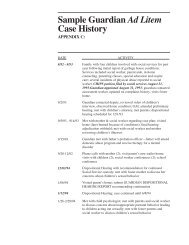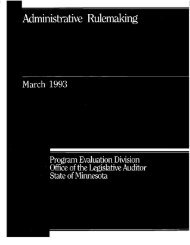Occupational Regulation - Office of the Legislative Auditor
Occupational Regulation - Office of the Legislative Auditor
Occupational Regulation - Office of the Legislative Auditor
You also want an ePaper? Increase the reach of your titles
YUMPU automatically turns print PDFs into web optimized ePapers that Google loves.
16 OCCUPATIONAL REGULATION<br />
in Figure 1.3. The 1998 report concentrates on <strong>the</strong> three areas <strong>of</strong> (1) regulatory<br />
boards and governance structures, (2) pr<strong>of</strong>essional practice authority, and<br />
(3) continuing competence. The 1998 report also includes helpful “legislative<br />
implementation templates” on all three issues.<br />
The history <strong>of</strong><br />
occupational<br />
regulation in<br />
Minnesota<br />
should be<br />
considered as<br />
<strong>the</strong> Legislature<br />
takes up <strong>the</strong><br />
issue.<br />
RECENT HISTORY OF OCCUPATIONAL<br />
REGULATION IN MINNESOTA<br />
Having presented <strong>the</strong> national history, criticisms, and major national reforms <strong>of</strong><br />
occupational regulation, we now review <strong>the</strong> recent history <strong>of</strong> occupational<br />
regulation in Minnesota. During <strong>the</strong> last quarter century, occupational regulation<br />
has been an important issue in Minnesota as in many o<strong>the</strong>r states. Some <strong>of</strong> <strong>the</strong><br />
noteworthy historical markers include:<br />
· <strong>the</strong> adoption <strong>of</strong> a sunrise law in 1976;<br />
· <strong>the</strong> establishment <strong>of</strong> a review process conducted by <strong>the</strong> Health Department<br />
to assess <strong>the</strong> need for regulation <strong>of</strong> health occupations in 1976;<br />
· a study <strong>of</strong> occupational regulation conducted by <strong>the</strong> Department <strong>of</strong><br />
Administration in 1976 and 1977;<br />
· recommendations concerning occupational regulation issued by <strong>the</strong><br />
Commission on Reform and Efficiency (CORE) in 1993; and<br />
· legislative hearings in 1991 and 1997, followed by <strong>the</strong> introduction <strong>of</strong> bills<br />
in 1992 and 1998 to change <strong>the</strong> system <strong>of</strong> occupational regulation.<br />
Sunrise in Minnesota<br />
Requests for occupational regulation proliferated in <strong>the</strong> 1970s. In Minnesota no<br />
more than 12 occupations gained state regulation in a single decade until <strong>the</strong><br />
1970s, when 40 occupations gained state regulation. In 1976 Minnesota<br />
responded by becoming one <strong>of</strong> <strong>the</strong> first states to enact sunrise legislation by<br />
amending Minnesota Statutes Chapter 214 to include a policy for <strong>the</strong> regulation <strong>of</strong><br />
new occupations. 53<br />
As discussed earlier in this chapter, sunrise legislation is a means <strong>of</strong> screening<br />
proposals for occupational regulation to ensure <strong>the</strong>y meet criteria for public<br />
protection. In Minnesota, three criteria were established in 1976:<br />
· Whe<strong>the</strong>r <strong>the</strong> unregulated practice <strong>of</strong> an occupation may cause a<br />
recognizable, and not remote, harm or danger to citizens <strong>of</strong> <strong>the</strong> state;<br />
53 Minn. Laws (1976), ch. 222, secs. 1-9.








